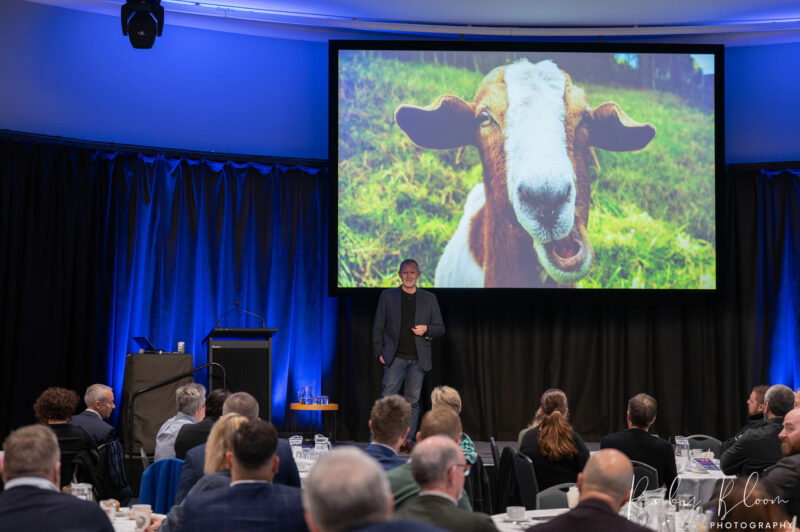
Ad agency owner and author Vaughn Davis recently visited Napier to talk small business. Here’s what he took back to Auckland with him.
It’s funny what you see when you look up.
I was in Napier for a couple of nights recently, meeting with business owners and giving a breakfast talk.
Between appointments I did a fair bit of walking, and as out-of-towners tend to do, a fair bit of gawking at the art deco architecture that’s helped put the city on the tourism map.
Now this might be an insight into my personality, but the thing that stood out for me about the rather lovely hotels, lawyers’ chambers, banks, offices and shops wasn’t the architectural aesthetic. It was the numbers on the buildings. 1932. 1933. The odd 1934.
Not chiselled into any of the facades I saw, but etched forever into New Zealand’s collective memory, was the number that started it all: 1931. The Napier Quake. 256 dead across the region and practically every CBD building destroyed by the earthquake or the fires that followed.
It was the greatest disaster the country had seen, and would have been even more challenging for a provincial town, a long way from anywhere.
But by the end of that year, the rubble had been cleared and the first major commercial building had been completed. By March 1932 – 13 months after the quake – 19 newly built shops were open. The rebuild continued until World War 2, creating the world-renowned architectural showcase thousands of tourists come to see every year. The sound shell, the old museum, the colonnade… all built quickly and well on the rubble and dust of disaster.
The dates on Napier’s post-earthquake buildings were front of mind when I got up to talk to 160 or so business owners, accountants and advisors the next morning. Cyclone Gabrielle had hit hard. If a business wasn’t directly affected, then its suppliers or customers were. Transport and labour issues were biting deep. All this on top of rising fuel prices, lending interest rates and general cost of living.
You’d think the mood in the room would be pretty grim. Maybe it was the kai, or maybe it was the view of the sunrise from the conference centre, but it was anything but. There was energy in the room. Curiosity. Optimism in the face of things being, to quote one hospo operator, a bit f*cked.
But Napier is a place literally built on bouncing back. To create a new, beautiful, CBD in the time it takes to get halfway through a resource consent today takes energy and optimism, despite what nature and the Reserve Bank throw at you.
I’d watched something in my hotel room the night before that seemed to tell the same story.
It was an old video of the Apollo 13 post-flight press conference (that’s the one that had an explosion on the way to the moon). Soon after the “Houston we have a problem” moment, mission control calculated the crew would run out of oxygen two thirds of the way home (making me wonder, of course, if the three-man crew considered the rather obvious, if slightly violent, solution).
Running out of oxygen would have been a pretty depressing prospect. But that’s not how Commander Jim Lovell (played in the movie by Tom Hanks) framed it. Instead, he added four words “Unless we do something.”
We’re going to run out of oxygen, unless we do something.
The earthquake will be the end of this town, unless we do something.
We won’t sell enough stock to pay the staff, unless we do something.
There aren’t enough customers to keep the business afloat, unless we do something.
Lovell and his crew didn’t know yet what the “something” was. The important thing was to commit to doing it. Figuring out what it was came next.
The business owners I met after the talk – including restaurateurs, a winemaker, an accountant, an advertising freelancer, a lawyer, a Māori leader, people running a boutique hotel, an art gallery, and a fashion store – didn’t need to be told that. Gabrielle was their earthquake and just like the business owners in Napier in 1931 they were ready to do something. They didn’t all know exactly what it was, and I certainly didn’t have all the answers. But they were looking for them, which is why they’d gotten up early, arranged for someone to take the kids to school and turned up at the conference centre.
I hope I gave them a few “somethings” to think about and maybe use to help their businesses bounce back. I suspect though that just being there; being in the room with 160 other people in similar boats, was just as valuable. It’s hard, owning a small business. When you’re in a big company there are plenty of people to bounce ideas off, celebrate successes with, and support each other through setbacks. When you’re the boss, the janitor, the bookkeeper and the head of marketing you don’t always get those opportunities.
So coming to hear some yarns from an Auckland advertising rooster can be as much a chance to make personal connections as it is to look at PowerPoint slides.
I’m not sure they flew in Aucklanders in 1931 to give pep talks. But I am sure that Napier’s business owners – who saw almost everything they owned turned to rubble and soot one January morning – didn’t need advice or consultants. They decided that they were going to do something. Then they worked out what that was, and did it.
Vaughn Davis owns advertising agency The Goat Farm and wrote “Covid Schmovid: 19 ways to make your small business boom”.

Own your own business within the CBD? To have access to all the membership benefits, register today.